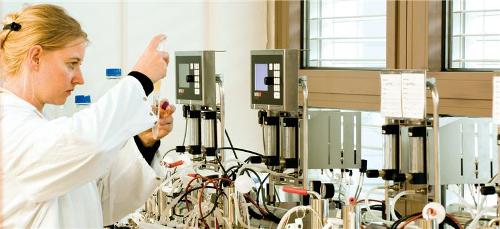At present, a large number of daily use products are produced using renewable resources. For example, household cleaners now include active surfactants that are made from sugar and plant oils. Surfactants are found in shampoos, shower gels, skin creams, household cleaners, dishwashing liquids, washing powders and other products.
 The researcher takes samples from the bioreactor.
The researcher takes samples from the bioreactor.
Till now, most surfactants are produced from crude oil, which has a limited supply. Hence, manufacturers are looking for alternatives and their focus is mainly on detergents produced from sustainable resources.
A team lead by Suzanne Zibek, an engineer and technical biologist at the Fraunhofer Institute for Interfacial Engineering and Biotechnology (IGB), is now producing surfactants using biotechnological approaches, with the aid of bacteria and fungi. The team has used mannosylerythritol lipids (MEL) and cellobiose lipids (CL) to produce biosurfactants that are effective and environmentally friendly. These materials are produced in a large volume by using smut fungus.
The enhanced structural diversity makes the biosurfactants to stand out from their competing materials. Additionally, these sustainable materials are less toxic and biodegradable. In spite of all these benefits, biological surfactants are used only in a small number of cosmetics and household products because they are expensive and difficult to produce.
Zibek stated that to increase the usage of natural surfactants, it is necessary to improve fermentation yields. To achieve this, the researchers are optimizing the manufacturing process to decrease production costs. Scientists have grown the microorganisms in a bioreactor, which includes a culture medium containing mineral salts, vitamins, oil and sugar. Main aim of the project is to reach high concentrations in the shortest possible time. The team has already achieved concentrations of 100 g/L for MEL and 16 g/L for CL. The next stage of the research is the separation of the biosurfactants from the medium and characterization of the substances depending on applications such as cosmetic, dishwashing liquids, and oven cleaning products. The final stage is the modification of the substances at the enzymatic level.